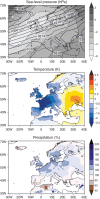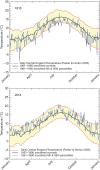Tambora 1815 as a test case for high impact volcanic eruptions: Earth system effects
- PMID: 31423155
- PMCID: PMC6686350
- DOI: 10.1002/wcc.407
Tambora 1815 as a test case for high impact volcanic eruptions: Earth system effects
Abstract
The eruption of Tambora (Indonesia) in April 1815 had substantial effects on global climate and led to the 'Year Without a Summer' of 1816 in Europe and North America. Although a tragic event-tens of thousands of people lost their lives-the eruption also was an 'experiment of nature' from which science has learned until today. The aim of this study is to summarize our current understanding of the Tambora eruption and its effects on climate as expressed in early instrumental observations, climate proxies and geological evidence, climate reconstructions, and model simulations. Progress has been made with respect to our understanding of the eruption process and estimated amount of SO2 injected into the atmosphere, although large uncertainties still exist with respect to altitude and hemispheric distribution of Tambora aerosols. With respect to climate effects, the global and Northern Hemispheric cooling are well constrained by proxies whereas there is no strong signal in Southern Hemisphere proxies. Newly recovered early instrumental information for Western Europe and parts of North America, regions with particularly strong climate effects, allow Tambora's effect on the weather systems to be addressed. Climate models respond to prescribed Tambora-like forcing with a strengthening of the wintertime stratospheric polar vortex, global cooling and a slowdown of the water cycle, weakening of the summer monsoon circulations, a strengthening of the Atlantic Meridional Overturning Circulation, and a decrease of atmospheric CO2. Combining observations, climate proxies, and model simulations for the case of Tambora, a better understanding of climate processes has emerged. WIREs Clim Change 2016, 7:569-589. doi: 10.1002/wcc.407 This article is categorized under: 1Paleoclimates and Current Trends > Paleoclimate.
Figures







References
-
- Self S, Gertisser R, Thordarson T, Rampino MR, Wolff JA. Magma volume, volatile emissions, and stratospheric aerosols from the 1815 eruption of Tambora. Geophys Res Lett 2004, 31:L20608. doi:10.1029/2004GL020925. - DOI
-
- Crowley TJ, Obrochta SP, Liu J. Recent global temperature ‘plateau’ in the context of a new proxy reconstruction. Earth's Future 2014, 2:281–294. doi:10.1002/2013EF000216. - DOI
-
- Wilson R, D'Arrigo R, Buckley B, Buntgen U, Esper J, Frank D, Luckman B, Payette S, Vose R, Youngblut D. A matter of divergence: tracking recent warming at hemispheric scales using tree ring data. J Geophys Res 2007, 112:D17103.
-
- D'Arrigo R, Wilson R, Tudhope A. The impact of volcanic forcing on tropical temperatures during the past four centuries. Nat Geosci 2009, 2: 51–56. 10.1038/ngeo393. - DOI
-
- Stommel HM, Stommel E. The year without a summer. Sci Am 1979, 240:176–186.
Publication types
LinkOut - more resources
Full Text Sources
Miscellaneous
